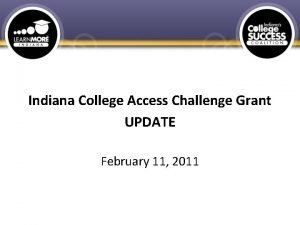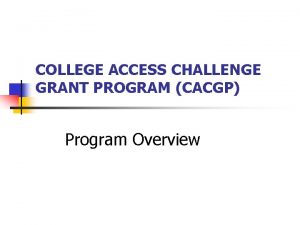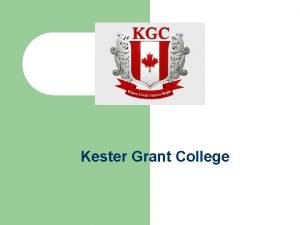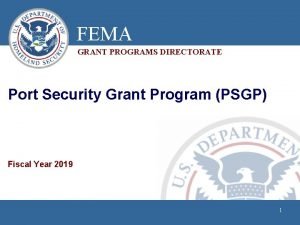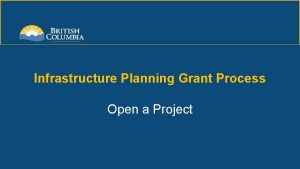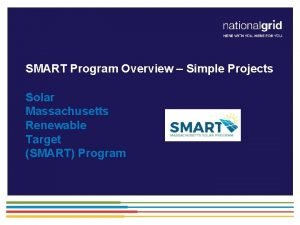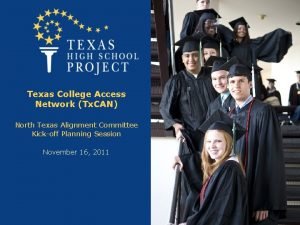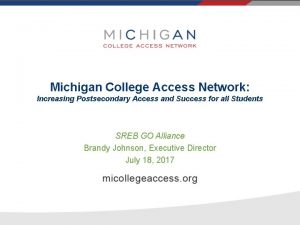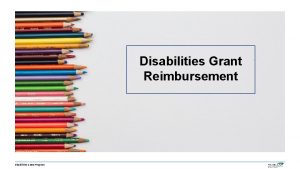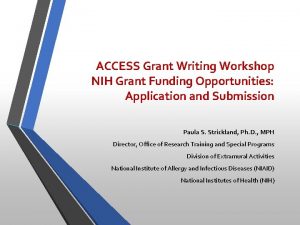COLLEGE ACCESS CHALLENGE GRANT PROGRAM CACGP Program Overview


















- Slides: 18

COLLEGE ACCESS CHALLENGE GRANT PROGRAM (CACGP) Program Overview

OVERVIEW Authorizing statute: The College Access Challenge Grant Program (CACGP) is twoyear formula grant program that was created as part of the College Cost Reduction and Access Act (CCRA) of 2007. Purpose: CACG is designed to support States in helping students and families to learn about, prepare for, and finance a postsecondary education. Appropriation: The CACG program received an appropriation of $66 million for FY 2008, and we expect an additional $66 million appropriation in FY 2009.

OVERVIEW (Cont. ) Allotment of Funds CACG funds are awarded to States based on a formula that considers the relative number of people between the ages of 5 and 17, and 15 and 44 who are living below the poverty line. The minimum amount a State can receive is $330, 000 for FY 2008. The tentative allotments for each state are posted to our Web site, www. ed. gov/programs/cacg. States may receive slightly larger allotments, if not all states apply for funding.

ALLOWABLE ACTIVITIES Provision of Information About College To Students and Their Families This includes information about the benefits of going to college, college opportunities, college financing, and career preparation, outreach activities, and providing assistance in completing the FAFSA.

ACTIVITIES (Cont. ) Financial Aid For College Students This includes need-based grant aid to students and student loan cancellation/repayment/or interest rate reduction for borrowers in high-need geographical areas or high-need professions.

ACTIVITIES (Cont. ) Professional Development This includes professional development for HS and MS guidance counselors, and financial aid administrators and college admission counselors at postsecondary institutions.

STATUTORY REQUIREMENTS Qualifying Students and Families States must make activities and services available to all qualifying students and families regardless of a) choice of postsecondary institution; b) type of student loan received; c) server of such loan; and d) student’s academic performance.

REQUIREMENTS (Cont. ) Non-Federal Matching Requirement Federal funds pay for two-thirds of the cost of project activities. CACG grantees must provide the other one -third from non-Federal sources (such as State appropriations or private contributions). The non. Federal share may be provided in cash or in-kind contributions. If a State fails to provide the full non-Federal share, the Secretary will reduce the amount of the grant proportionately.

REQUIREMENTS (Cont. ) Annual Performance Report States are required to provide an annual performance report that outlines the activities and services, associated costs of each activity or service, the number and percentage of students that participated in activities and services, and the total non-Federal matching contribution. This information will be used to determine if projects are achieving their goals and objectives.

REQUIREMENTS (Cont. ) States may award sub-grants to one or more non-profit organizations (or partnerships of organizations) that: 1) have been in existence prior to September 21, 2007, and 2) have experience in implementing activities and services related to increasing access to higher education.

RESTRICTIONS Students living below poverty line. Priority must be given to students living below the poverty line. Fees. Grantees may not charge fees to students or their parents for the provision of services. Loans. States cannot use funds to promote any lender’s loans.

RESTRICTIONS (Cont. ) Administrative Costs States cannot use more than 6% of funds received for administrative costs. ED will defer to states in defining what costs are administrative, but States must define “administrative costs” consistently across programs. Examples of administrative costs could be the salaries of staff administering the CACG project, travel and training expenses of such staff, etc. The cap on administrative costs does not apply to subgrantees.

RESTRICTIONS (Cont. ) Indirect Costs There is also an 8% cap on the use of funds for indirect costs. Your organization must have an negotiated Indirect Cost Rate (ICR) to receive CACG funds. The negotiated ICR agreement defines which costs are included in the indirect cost rate pool.

EVALUATION It is critical to consider how your state will evaluate accomplishments annually. The application requires States to present: n Objectives; n Activities; and n Quantitative Measurement.

EVALUATION (Cont. ) n n We encourage you to establish two or three measurable, focused objectives based on your State’s needs. Once two or three measurable objectives have been established, three to five target activities can be developed for each objective. These will form the basis of your implementation plan.

EVALUATION (Cont. ) n n Limiting your implementation plan to two or three measurable and focused objectives with three to five targeted activities each will increase the probability of your plan’s success and facilitate measuring the extent of its success. Project management should measure or estimate the number of persons served by each targeted activity and establish a mechanism for reporting the outcomes of the objectives.

PROGRAM SCHEDULE n n n The application is available on the CACG Web site, www. ed. gov/programs/cacg. The closing date is June 27. States must submit the application electronically to cacgp@ed. gov. We expect to make awards by the end of July/early August.

CONTACT INFORMATION n n Lynn Mahaffie, Director Teacher and Student Development Services Program lynn. mahaffie@ed. gov 202 -502 -7903 Karmon Simms-Coates, Program Manager College Access Challenge Grant Program Karmon. simms-coates@ed. gov 202 -502 -7807
 College access challenge grant
College access challenge grant Cacgp
Cacgp Fallon sherrock smoking
Fallon sherrock smoking Wake tech admissions
Wake tech admissions What is washington college grant
What is washington college grant Kester grant college
Kester grant college Terminal access controller access control system plus
Terminal access controller access control system plus Terminal access controller access-control system
Terminal access controller access-control system Port security grant program
Port security grant program Infrastructure planning grant program
Infrastructure planning grant program Infrastructure planning grant program
Infrastructure planning grant program Lcif grant application form
Lcif grant application form Sbic program
Sbic program Overview on the national tuberculosis elimination programme
Overview on the national tuberculosis elimination programme Solar massachusetts renewable target (smart) program
Solar massachusetts renewable target (smart) program Acessrio
Acessrio Txcan
Txcan Michigan college access network
Michigan college access network Early college high school at midland college
Early college high school at midland college
